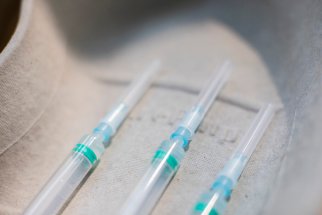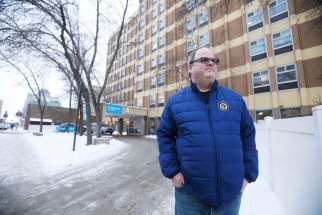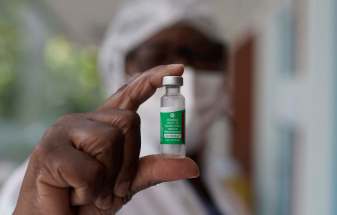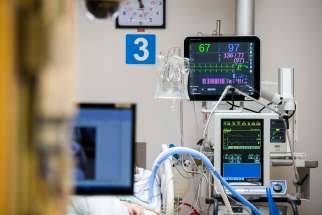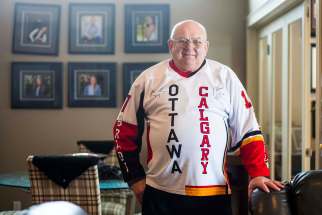Vaccine-eligibility priorities to include younger First Nations people Plan designed to free up hospital capacity, provincial officials say
Read this article for free:
or
Already have an account? Log in here »
To continue reading, please subscribe:
Monthly Digital Subscription
$0 for the first 4 weeks*
- Enjoy unlimited reading on winnipegfreepress.com
- Read the E-Edition, our digital replica newspaper
- Access News Break, our award-winning app
- Play interactive puzzles
*No charge for 4 weeks then price increases to the regular rate of $19.00 plus GST every four weeks. Offer available to new and qualified returning subscribers only. Cancel any time.
Monthly Digital Subscription
$4.75/week*
- Enjoy unlimited reading on winnipegfreepress.com
- Read the E-Edition, our digital replica newspaper
- Access News Break, our award-winning app
- Play interactive puzzles
*Billed as $19 plus GST every four weeks. Cancel any time.
To continue reading, please subscribe:
Add Free Press access to your Brandon Sun subscription for only an additional
$1 for the first 4 weeks*
*Your next subscription payment will increase by $1.00 and you will be charged $16.99 plus GST for four weeks. After four weeks, your payment will increase to $23.99 plus GST every four weeks.
Read unlimited articles for free today:
or
Already have an account? Log in here »
Hey there, time traveller!
This article was published 01/02/2021 (1781 days ago), so information in it may no longer be current.
First Nations people across Manitoba can expect to get vaccinated against COVID-19 at a much younger age than the general population, as the virus continues to wreak havoc on Indigenous communities across the province.
“When the province is doing, for example, 60 year olds, we would anticipate First Nations people over age 40 being eligible,” said Dr. Marcia Anderson, a medical officer of health.
“Some will look at that, and at face value say that seems unfair.”
Anderson, who sits on the province’s vaccine implementation task force, was among provincial health officials who unveiled the priority groups selected by First Nations leaders.
“What we want to do is close the gaps. We want First Nations to not be hospitalized at five times the rate we would expect, based on the population proportions,” Anderson said.
The median age for both hospitalization and deaths is 17 years younger among First Nations members, compared with the rest of Manitoba’s population, she said.
“Our data shows us that it’s very clearly First Nations people who are experiencing greater harms at early ages,” said Dr. Joss Reimer, the medical lead for Manitoba’s vaccine rollout.
She said the plan will help shore up overall hospital capacity, because so many First Nations patients with COVID-19 are currently in critical care.
“Any of us could, at any time, need that hospital bed, for a COVID- or a non-COVID-related outcome,” Reimer said.
First Nations leaders have decided to prioritize reserves accessible only by air and winter roads, as they tend to have the least medical support.
However, they will still focus on First Nations people elsewhere. Anderson noted that cases have been quite high in the North, but until recently it was First Nations people living in Winnipeg who had the highest share of cases.
Anderson said bands will be able to choose prioritization for “traditional healers/knowledge keepers” based on their own cultural practice, and that many have roles in medicine such as praying, administering medicines and touching people who are ill.
She also said the groups being prioritized could shift with medical outcomes, for example, if youths or people from southern reserves suddenly make up a large number of hospitalizations.
Both doctors said the province intends to take First Nations representation into account when it prioritizes congregate living facilities for shots, such as jails, homeless shelters and some care homes.
Anderson noted that overcrowded homes in First Nations communities mean that people living on a reserve who are exposed to someone with COVID-19 are roughly four times as likely to get infected compared with someone in the general population who is exposed to a COVID carrier.
First Nations communities tend to have limited health-care services and a higher instance of diseases that make COVID-19 worse, such as diabetes and asthma.
The youngest Manitoban to die of COVID-19 to date was a First Nations boy under the age of 10.
“We know that there are many factors related to colonization and systemic racism that have led to this heightened risk,” Anderson said.
No vaccine exodus to reserves: doctors
Premier Brian Pallister’s worst fears of First Nations storming their home reserves to get vaccinated have not come to pass, doctors said Monday.
“We have actually not seen a rush of people going back to their First Nations communities,” Dr. Marcia Anderson, a medical officer of health, said Monday.
On Dec. 1, 2020, Pallister said he had concerns that people in cities with band membership in remote communities would fly home to get a jab earlier, thus possibly exposing relatives to COVID-19.
Premier Brian Pallister’s worst fears of First Nations storming their home reserves to get vaccinated have not come to pass, doctors said Monday.
“We have actually not seen a rush of people going back to their First Nations communities,” Dr. Marcia Anderson, a medical officer of health, said Monday.
On Dec. 1, 2020, Pallister said he had concerns that people in cities with band membership in remote communities would fly home to get a jab earlier, thus possibly exposing relatives to COVID-19.
His comments riled First Nations chiefs.
Two months later, vaccine medical head Dr. Joss Reimer said Monday she hadn’t heard of individuals going into reserves to get shots.
Anderson noted that First Nations people are “highly mobile,” often having a residence both on the reserve and in cities like Winnipeg or Thompson, so some may have gotten the jab and returned to their other home.
“But have not heard about mass movement from urban areas to First Nations communities for these purposes.”
—Dylan Robertson
Monday’s announcement did not pertain to Métis or Inuit people. The doctors mentioned possibly rolling out vaccination sites in First Nations communities, but there is no plan to do so in locations with large Métis populations.
The Trudeau government has asked Manitoba to put Métis people on the vaccine task force, where First Nations leaders sit. Instead, the Manitoba Metis Federation has been invited only to look at communications around hesitancy, and how to get people to large immunization sites.
The Pallister government insists it wants to include all Indigenous people, and the premier said he’s pushed to have Ottawa deliver doses earlier so vulnerable Métis people get immunized.
Yet NDP MLA Ian Bushie, the critic for indigenous issues, said the premier had focused too much on “dog-whistle politics.”
dylan.robertson@freepress.mb.ca


